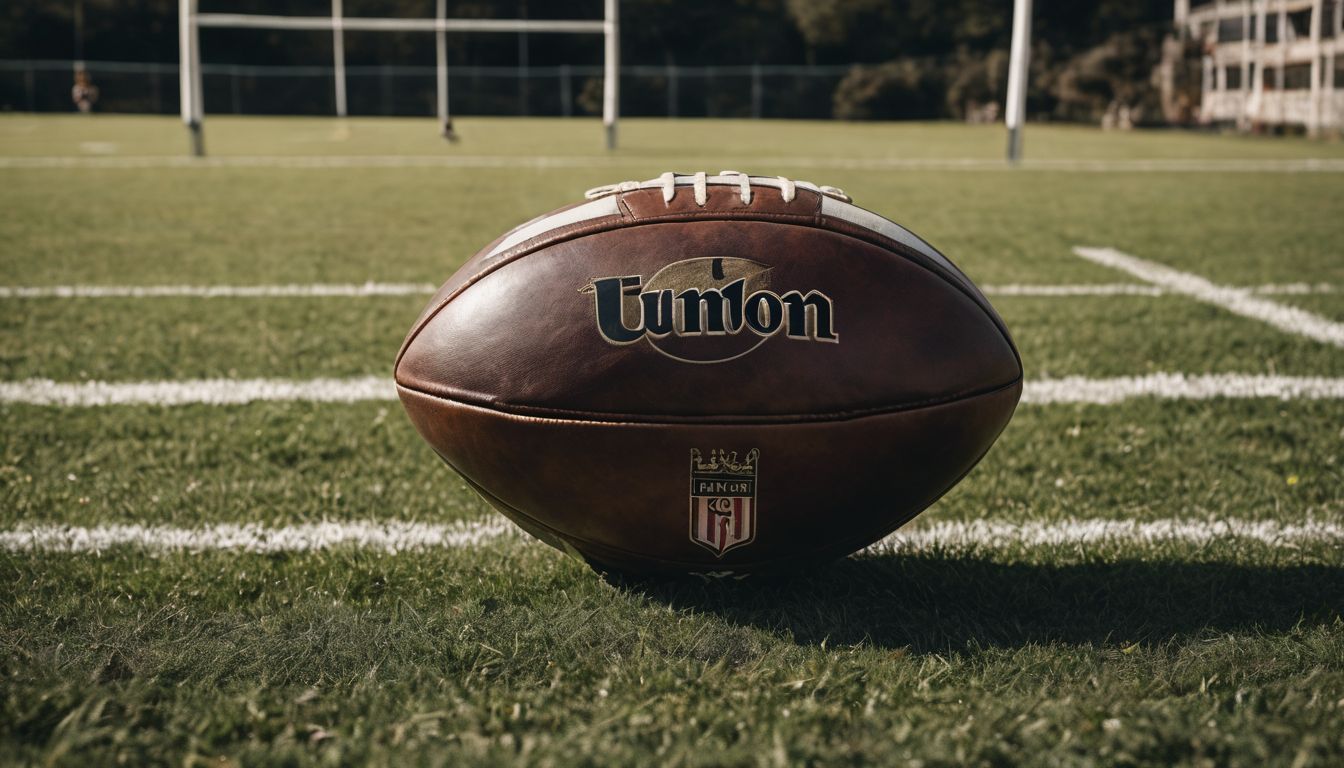In the heat of a rugby match, knowing what’s happening on the pitch is crucial. Imagine watching players cluster together in an intense show of strength and strategy; that’s a maul.
This post explores this dynamic play, unpacking its rules and impact on the game, so you can enjoy every ruck and run with clarity. Dive in to learn about the mighty maul!
Key Takeaways
- A maul in rugby is a tactical formation where the ball carrier, backed by teammates, pushes against opposition players to gain ground while keeping the ball off the ground.
- Key components of a successful maul include strength and coordination from the ball carrier and supporting players, and strategic disruption by opponents aiming to regain control.
- Rules governing mauls ensure fair play; for example, players must join from behind the backmost teammate and stay on their feet without collapsing or handling the ball inappropriately.
- Defending against a maul requires maintaining a strong grip on opponents, effective body positioning for stability, and creating counter rucks to disrupt forward momentum.
- Mastering both offensive strategies such as “truck and trailer” plays and defensive tactics like counter-rucking can significantly impact field position and scoring opportunities during rugby games.
Understanding Maul in Rugby
The maul in rugby involves a group of players from both teams coming together in a contest for the ball. It is different from a tackle and ruck, requiring its own set of skills and strategies.
You are currently viewing a placeholder content from Default. To access the actual content, click the button below. Please note that doing so will share data with third-party providers.
More InformationDefinition and explanation
A maul in rugby isn’t a free-for-all scramble; it’s a tactical move where the ball carrier, tightly gripped by at least one defender, is backed up by teammates who latch on. This creates an interlocked unit, pushing forward to gain valuable ground while still keeping hold of the ball.
Key to this manoeuvre are strength and coordination: teammates must commit their force collectively without losing balance or control of the moving mass.
Mauls distinguish themselves from tackles and rucks due to players remaining on their feet and the ball staying off the ground. It’s a show of power and unity as opponents attempt to halt progress while defenders work together like parts in a well-oiled machine, leveraging body positions against each other with precision.
Success hinges on seamless operation – any breakdown in support for the carrier can swiftly turn potential advance into lost opportunity.
Key differences from a tackle and ruck
Now that we’ve defined what a maul is, let’s delve into how it stands out from similar rugby scenarios, such as tackles and rucks. Understanding these distinctions is crucial for fans and players alike to fully grasp the dynamics of the game.
| Maul | Tackle | Ruck |
|---|---|---|
| Occurs when the ball carrier is held by one or more opponents, and teammates bind on to the carrier | Happens when a ball carrier is brought to ground by an opponent | Forms after a tackle when at least one player from each team is on their feet and over the ball |
| The ball must not touch the ground during a maul | Ball carrier must release the ball after being brought to ground | Players must use their feet to move the ball and cannot pick it up by hand |
| Players aim to stay on their feet and move forward | Play is momentarily paused until the ball is released | Contested by players on their feet trying to push the opposition off the ball |
| It’s a coordinated team effort to gain ground while protecting the ball carrier | Isolated event focusing on the ball carrier and the tackler | Focuses on competition for the ball post-tackle |
| Can lead to substantial territorial gains when executed well | A successful tackle can halt the opponent’s momentum | Offers a chance to win back possession and reorganise defence or attack |
Each aspect of the game from mauls to tackles and rucks is a strategic play that can significantly alter the momentum and can be the difference between winning and losing possession.
Components of a Maul
The components of a Maul in rugby include the ball carrier, opponents, and teammates. Each player has a specific role to play in maintaining possession and moving the maul forward.
You are currently viewing a placeholder content from Default. To access the actual content, click the button below. Please note that doing so will share data with third-party providers.
More InformationBall carrier
The ball carrier in a rugby maul is held by opponents while teammates work to support and protect them. This requires strength, determination, and teamwork to maintain possession of the ball and advance towards the opposition’s territory.
As one of the key components of a maul, the skill and coordination of the ball carrier are crucial for the success of this strategic move.
A coordinated effort between the ball carrier and their teammates is essential to successfully execute a maul. The ball carrier must be able to withstand pressure from opponents while relying on their teammates for support.
Opponents
The opponents play a crucial role in a maul. They aim to prevent the ball carrier and their teammates from gaining ground or retaining possession of the ball. It involves physical strength, body positioning, and strategic movements to disrupt the formation of the maul and ultimately regain possession of the ball.
Opponents must work together to counteract the force and coordination of the attacking team, using techniques such as leverage, pushing against the maul’s movement, and creating counter rucks to break up the formation.
In addition to physicality, opponents need keen tactical awareness to anticipate where the maul is heading and react quickly with coordinated defensive efforts. Successful defense against a maul can turn momentum in favor of their team while thwarting scoring opportunities for their opponents.
Teammates
Teammates play a crucial role in the maul formation. When a ball carrier is held by opponents, it’s up to their teammates to bind onto them and work together to drive the maul forward.
This requires strong coordination and communication among the teammates, as they must maintain their grip on the ball carrier while pushing and driving as a unit. The support of the teammates is essential for the success of the maul, as they provide protection for the ball carrier and help create momentum to gain ground on the field.
In a maul, opponents try to disrupt the movement of not only the ball carrier but also his teammates. The cohesive effort of binding onto each other allows them to withstand these disruptions and continue moving forward.
How a Maul Works
The maul is formed when a ball carrier is held by one or more opponents and one or more teammates bind onto the ball carrier. This results in a dynamic pushing and shoving contest to gain territory on the field.
Rules and regulations govern how a maul can be used effectively during gameplay, making it an essential skill for rugby players to master.
You are currently viewing a placeholder content from Default. To access the actual content, click the button below. Please note that doing so will share data with third-party providers.
More InformationFormation and movement
The maul forms when the ball carrier is held by opponents and one or more of their teammates bind onto them. The formation typically involves players from both teams, creating a tight-knit group around the ball carrier.
The ball is kept off the ground while the group moves forward as a unit, aiming to gain ground and retain possession of the ball.
Teammates work together to move the maul forward by staying bound together and driving with their legs. This coordinated movement allows the team in possession of the ball to advance while protecting it from being stolen by opponents.
Rules and regulations
After understanding the formation and movement of a maul, it is essential to grasp the rules and regulations that govern its execution. The laws of rugby stipulate that once a maul has formed, any player can join from any direction as long as they bind onto the backmost player in the maul.
Players involved in a maul must stay on their feet at all times, and they cannot intentionally collapse the maul. Additionally, players are not allowed to use their hands or arms to handle the ball when it’s in a maul.
Moreover, once a maul stops moving forward for five seconds or more, the referee will instruct one team to use it or play on.
Tips to Defend Against a Maul
To defend against a maul, players should maintain a strong grip, use effective body positioning, and create counter rucks to disrupt the opposing team’s momentum. These defensive strategies are essential for preventing the ball carrier from gaining ground and keeping possession of the ball.
Maintaining a strong grip
To maintain a strong grip in a maul, players need to focus on securing the ball carrier and fending off opponents. By using leverage and body positioning, teammates can work together to ensure a solid hold on the ball carrier.
This allows them to drive forward as a unit, gaining ground and maintaining possession of the ball. Effective communication among teammates is crucial to coordinate their efforts and withstand opposition pressure during the maul.
Players must also be aware of legal techniques for binding into the maul, ensuring that they are not infringing upon rugby regulations while maintaining their grip. Additionally, leveraging their strength and positioning within the maul enables them to better resist attempts by opponents to disrupt their hold on the ball carrier.
Using body positioning
To defend against a maul, players must focus on using effective body positioning. This involves getting low and placing the body in a strong, stable stance to resist the opponent’s force.
By keeping the hips lower than the shoulders and driving them forward into the opposing team, players can effectively hold their ground and prevent the maul from advancing. Additionally, maintaining a wide base of support through spreading legs apart provides better stability and resistance against opponents’ attempts to push through.
Players can also use their body positioning to drive back in response to an opponent’s movement or to create leverage for breaking up the maul. By understanding how to position their bodies relative to teammates and opponents within the maul, players can strategically influence its direction and outcome.
Creating counter rucks
Using body positioning can be crucial when defending against a maul, but creating counter rucks is equally important. The key to this defensive tactic is the ability of players to engage and drive over the ball on the ground after the initial contact in order to disrupt and win possession.
It involves swift and coordinated action from teammates, using leverage and strength to overpower the opposition. By swiftly reacting to the maul formation and driving over at just the right moment, players can effectively halt their opponents’ progress and force turnovers, shifting momentum in their favor.
Creating counter rucks requires precision timing and quick thinking, with players strategically working together as a cohesive unit. This defensive maneuver demands physicality while also being highly tactical, enabling teams to regain control of possession or even turn defense into a scoring opportunity.
How a Maul Can Impact a Rugby Game
A well-executed maul can help a team gain significant territory and create scoring opportunities, while an ineffective one can result in turnovers and loss of possession. To learn more about the impact of mauls in rugby games, keep reading!
Advantages and disadvantages
A well-executed maul can provide several advantages in rugby. It allows the team to maintain possession of the ball while advancing down the field, creating an opportunity to score points. Additionally, a successful maul enables the team to exert physical dominance over their opponents, showcasing strength and teamwork. However, a poorly executed maul can result in turnovers or penalties, giving the opposing team an advantage and potentially leading to lost opportunities for scoring.
Understanding how to defend against a maul is crucial for preventing these disadvantages. Maintaining a strong grip and using effective body positioning are essential tactics when defending against a maul. Creating counter rucks also presents an opportunity to disrupt the opponent’s momentum and regain control of the game. Nonetheless, failing to effectively defend against a maul could lead to conceding ground or even points, making it imperative for teams to master this aspect of rugby strategy.
Common strategies and plays
Executing effective strategies and plays is crucial when it comes to mauls in rugby. One common strategy is the “truck and trailer” technique, where teammates bind together with the ball carrier at the front of the maul, creating a powerful driving force.
This coordinated movement helps to advance the maul downfield while maintaining possession of the ball. Another key play involves shifting the point of attack during a maul, catching opponents off guard and exploiting gaps in their defensive line.
These strategic approaches capitalise on teamwork and precision to gain ground and outmanoeuvre the opposition.
Teams also employ various deceptive plays within a maul, such as using disguised passes or unexpected movements to confuse defenders. By incorporating feints and quick changes in direction, players can create openings for their teammates to exploit.
Additionally, adapting plays based on field positioning can provide tactical advantages; for instance, near the try line, teams might opt for low drives that utilise brute strength while further from goal may involve more dynamic movements aiming for territorial gains.
Conclusion
Understanding the mechanics of a maul is crucial for success in rugby. It involves coordinated effort, strong grips, and strategic body positioning. Knowing how to defend against a maul can make a big difference on the field.
The impact of a well-executed maul can greatly influence the outcome of a rugby game. Recognising its advantages and disadvantages is key for both offence and defence strategies in this sport.
FAQs
1. What exactly is a maul?
A maul is a heavy, long-handled tool with a wedge-shaped head used for chopping and pounding, similar to an axe but typically heavier.
2. How does a maul work when splitting wood?
When you swing the maul down onto wood, its wedged shape forces the wood apart, making it great for chopping through large pieces or levering them into smaller ones.
3. Can I use a maul for tasks other than splitting logs?
Yes, besides chopping logs, you can also use it for driving in stakes or wedges with the pounding surface on the back of its head.
4. What makes the design of a maul effective for its purpose?
The design includes a sturdy construction meant to withstand repeated swinging and striking; this robustness allows users to exert powerful force on tough materials without damaging the tool.
5. Is there any special technique required when using a maul?
For best results and safety while using a maul, stand with your feet shoulder-width apart and swing with controlled power from over your head down toward your target in one fluid motion.
















